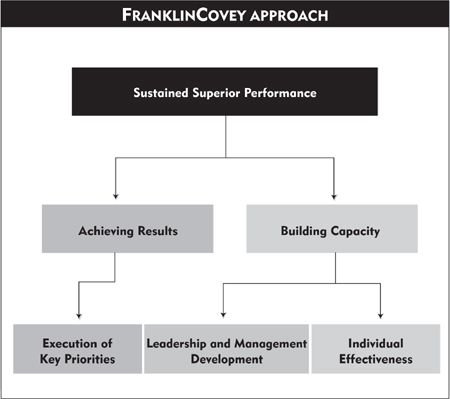
SUSTAINABLE, SUPERIOR PERFORMANCE . . .
That’s the tough part about business and most any organization. Sure, almost anyone can deliver results for a quarter or two. But the real challenge is to create an organizational culture that can deliver consistent results year after year.
Amazingly, few organizations can do it. Consider the following statistics from leading business publications:
• Profit from the Core: only 111 of 1,854 companies (13 percent) were able to generate sustained profitable growth for a ten-year period.
• Good to Great: only 126 of 1,435 companies (9 percent) managed to outperform the equity market averages for a decade or more. Further, only 11 of 1,435 companies (less than 1 percent) met the study’s criteria for sustained superior performance.
• Creative Destruction: only 160 of 1,008 companies (16 percent) studied over a thirty-year period managed to remain in existence at all.
• Stall Points: only 5 percent of the Fortune 50 successfully sustained their growth.
Delivering superior performance while building the capability to do it again and again is the definition of a great organization. Yet most organizations and their leaders fail to achieve this. The roots of their failure lie in their approach.
One day a poor farmer discovers in the nest of his pet goose a glittering golden egg. At first, he thinks it must be some kind of trick. But on second thought, he decides to take the egg and have it appraised.
The farmer can’t believe his good fortune. The egg is pure gold! He becomes even more excited the next day when the goose lays another golden egg. Day after day, he awakens to rush to the nest and find another golden egg. Soon he becomes fabulously wealthy.
But with wealth comes greed and impatience. Unable to wait day after day for the golden eggs, the farmer decides to kill the goose and get them all at once. But when he opens the goose, he finds it empty. There are no golden eggs—and now there is no way to get any more. The farmer has destroyed the very thing that produced them.
Within this fable is a key principle of organizational performance. Sustained, superior performance is a function of two things: what is produced (the golden eggs) and the capacity to produce (the goose).
If organizations focus only on producing golden eggs (achieving results today) and neglect the goose (building capability for tomorrow) they will soon be without the asset that produces golden eggs. On the other hand, if organizations only take care of the goose with no aim toward the golden eggs, they soon won’t have the wherewithal to feed the goose. The key lies in the balance.
Maybe your organization is like this:
When confronted with pressure to deliver results, we pull out all the stops. We create a program to marshal the troops and push everyone to achieve the urgent objective. One time it may be a sales goal. The next crisis may be a cost-cutting goal. The next time it will be something else. We’re constantly reactive, lurching from one “critical objective” or “emergency initiative” to the next. The problem is that we always seem to underinvest in the people, processes or equipment we need to really improve our business. As a result, we can never get into a rhythm of consistent performance.
Or, maybe your organization is like this:
We invested heavily in people and culture for many years. Our theory was that great, talented people with the best systems and technologies,
would automatically generate sustained superior performance. It was a great place to work, but then the hard times hit. We found that we really didn’t have the hard-coded ability to execute in the face of tough competition and an unfavorable economic environment. We were forced to cut back on all the investments people were used to during the golden years. People have become disillusioned, morale has tanked and many of our best people are leaving.
FranklinCovey has learned this lesson the hard way because we, too, have vacillated on this performance–performance capability pendulum. It has therefore become an “earned” learning and our approach has more than theoretical conviction behind it.
At FranklinCovey we approach the goal of sustained superior performance from both sides of the equation. We help organizations focus on and deliver specific results. We also help them build more capability—leaders and individual contributors that can have the capability to perform at new levels.
Under these two areas (Achieving Results and Building Capability) FranklinCovey works with clients in three distinct “jobs to be done.” They represent the three core areas of greatness embodied in The 8th Habit: organizational greatness, leadership greatness and personal greatness.
Consider for a moment how you might build a championship sports team. By investing in the quality and conditioning of the athletes, your team will improve—better players make better teams. At the same time, no matter how good the individual players, the team only wins if they can work together against specific objectives and “execute the play” again and again with excellence.
What you want is great players and great execution. A team that can perform consistently season after season—a winning franchise. This is the essence of the FranklinCovey approach: translating organizational capabilities into specific results again and again, resulting in a winning organization.